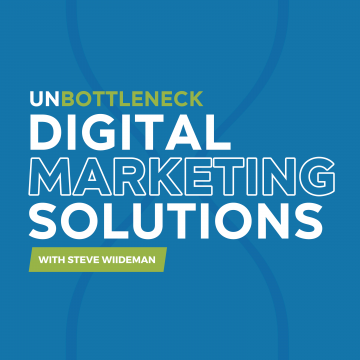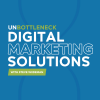Podcast: Play in new window | Download
In this episode of the Unbottleneck Podcast, Steve Wiideman is joined by one of his personal heroes, renowned marketing expert, Tim Ash, for a perceptive discussion about conversion rate optimization and the psychological factors that influence consumer behavior.
About Our Guest: Tim Ash
As an international keynote speaker and bestselling author, Tim Ash is an esteemed expert on evolutionary psychology and digital marketing whose grind never stops! His new bestselling book, “Unleash Your Primal Brain: Demystifying How We Think and Why We Act”, is already a staple in the marketing world as a universal guide explaining how the brain works — highly applicable to both business and personal relationships.
With over 20 years of experience, his journey began with a love for persuasion and psychology. He was the founder and CEO of strategic digital optimization agency, SiteTurners, where he has helped clients earn over $1.2 billion in revenue worldwide!
He is also the founder of the Digital Growth Unleashed international conference series which helps marketers understand the art and science of conversion rate optimization and he is here to share his expertise with us!
Sponsored by Ryte
Featured in this episode:
- Why Focus on Conversion Rate Optimization (CRO)?
- Best Practices for Conversion Rate Optimization
- Landing Page Success
- Nailing the User Experience
- Detailing the Pain Points of Not Taking Action
Conversion Rate Optimization (CRO): What’s the Point?
You’ve done the hard part! You’ve implemented search engine optimization (SEO) best practices and you are now driving consistent traffic to your website. Now what’s next?
Traffic is a great source of prospects and customers that can increase your business, so you’ll want to get the most out of it. Once you get the traffic, you want people to convert to customers, clients, subscribers or viewers. This can be done through conversion rate optimization, or CRO.
CRO is about having the right elements in place to persuade people to do something on your website that will add value to your business (download a guide, watch a video, fill out a contact form, etc.). CRO is not just about optimizing your website, but it’s about optimizing your whole business to support your objectives.
Conversion plays a critical role in ranking in search engines such as Google. However, rankings cannot be sustained by traffic alone. Google looks at how users are interacting with your website, including how long they stay on your page and what actions that take on that page.
CRO Best Practices
To get the most out of your website traffic, you need to make sure that you are optimizing your page to maximize opportunities for conversion. This can be done using the following best practices:
- Keep Your Promise – The language on your page should be in alignment with the user experience. If you promise something, you should be able to provide it without an issue.
- Proper Functions – Your site should have a clear call to action that makes it easy for a user to follow through without a hitch. It should be free of any errors that will make it difficult to complete a desired action.
- Relevant Content – Any page on your site can be a landing page and people are not always going to arrive via your homepage. Therefore, all your content should be relevant to user intent whether they come through organic search, referral or your home page.
- Reporting Engagement – There are many metrics available to measure your conversion rates, however, it’s important to make it a practice of studying long term metrics. Don’t get stuck on small metrics, but instead, focus on key metrics that will help you establish lifetime customer value.
- Trust Signals – To build authority, you must establish trust by showing that your business, product or service is the “real deal.” You can so this by adding several trust signals to your website such as:
- Appearance (ex. Professional Design)
- Trust Badges (ex. Secure Shopping)
- 3rd Party Validation (ex. Associations, Editorial Features)
- Social Proof (ex. Review, Testimonials)
Pro-Tip: Place these trust signals in the most appropriate areas of your website to gain the proper visibility such as the homepage and checkout pages.
Is Your Landing Page Really Landing?
The key to conversion is making sure users stay on your page. If your web page design is not user friendly, it can actually make them return to Google to find another competing website to find what they’re looking for. Here are some key design elements that could be affecting how users interact with your page:
- Not Keeping Your Promise – As mentioned above, the language on your website should be in alignment with its functionality. It should be quick and easy to take actions such as booking a free consultation, placing an order or even watching a tutorial without error.
- Too Much Text – large blocks of text can be hard to read so make sure that you’re making text readable by breaking it up and using an appropriate font size.
- Distracting Graphics – avoid “over decorating” your website with graphics as it can become overwhelming and ultimately slow down page speed.
- Slow Page Speed – time is money….literally! Page speed can become the deciding factor on whether or not a user will take action. Don’t keep them waiting.
User Experience: Don’t Make Me Think
The user experience plays a critical role in CRO. Users do not want to put in more effort then they have to in order to get what they want — and you shouldn’t make them. Therefore, you should prioritize making the user experience as seamless as possible by giving them what they are looking for. There are three types of user experience loads that can make or break your conversion:
- Visual Load – anything you can inspect with your eyes that makes it easy for users to proceed with an action (ex. Call to action buttons in view).
- Motor Load – voluntary motion on a user’s part that requires an extra step before proceeding with an action (ex. Scroll, drop-down list).
- Cognitive Load – overwhelming or unclear content that requires the user to think rather than take action (ex. Too many menu items)
Ultimately, your goal should be to make it as easy as possible for users to make an action on your website without having to do any additional research or navigation. This can be done by adding or enhancing visual elements of your website to increase conversion.
Bonus: No Pain, No Gain
Studies have shown that people tend to tune into pain avoidance rather than immediate pleasure. While highlighting a product or service’s benefits and/or features is great, it is not enough to get users to convert to paying customers or clients.
As a marketer, the best way to motivate someone to take action is by detailing the pain points of not taking action. With this in mind, we’re giving you permission to focus on the negative! Detail the consequences of not buying a product or service – spending more money over time, possible legal trouble, health issues, decreased social life, etc.
This approach really taps into people’s innate behavior to avoid foreseeable consequences that can hurt them in the long run.
Keep up with the best content, conversion rate and digital marketing strategies. Follow Steve on LinkedIn!




